| View previous topic :: View next topic |
| Author |
Message |
cooltouch


Joined: 15 Jan 2009
Posts: 9096
Location: Houston, Texas
|
 Posted: Tue Jan 23, 2018 1:20 am Post subject: 2 Cheap Zooms Posted: Tue Jan 23, 2018 1:20 am Post subject: 2 Cheap Zooms |
 |
|
cooltouch wrote:
And I do mean cheap. The 80-200 I've owned since 2009, paid about $10 for it back then, near as I can recall. The 70-210 I bought just last week. Paid $6 for it. Cost more than that to get it shipped to me.
But who on Earth cares, right? Well, I care. I've mentioned this here before, but I'll go ahead and mention it again. I care because the Albinar 80-200mm f/3.9 zoom was the very first zoom I ever bought. Back then I was a complete newbie at photography. This was back in 1982 or maybe early 1983. I had just bought a Canon AE-1 and I was getting tired of having only a 50mm f/1.8 lens to use with my picture taking adventures. So I went back to the store where I bought the camera and saw that they had a Canon FD 70-210mm f/4 -- which I thought was too expensive -- and an Albinar 80-200mm f/3.9 -- which was much closer to my budget. It was about $80. Not knowing anything about optical quality, I just figured that the 80-200 would be "good enough" so being blissfully ignorant, I bought the Albinar and went merrily on my way. I ended up shooting with that lens -- a lot -- over the next few years before I finally replaced it with something considerably better -- a Tamron SP 23A 60-300mm f/3.8-5.4, at about three and a half times the price I paid for the Albinar. By that point I knew a lot more about optical quality, but the funny thing was I had continued to use the Albinar because it took such good photos. And I ended up getting the Tamron, really, because I wanted that extra reach that it provides.
When I got back into manual lenses about 9 years ago, one of the very first lenses I bought was the 80-200/3.9 Albinar I own now. Except I bought one in Nikon AI mount so I could use it with my EOS DSLR. I bought it for one reason only: that feeling of nostalgia that often propels me when my rational self is temporarily absent. I haven't used it much since then. I've just been content to have it -- just in case a wave of nostalgia washes over me and all.
Well, fast forward nine years and a week ago or so, I was browsing through the listings at shopgoodwill.com and came across an Albinar 70-210mm f/3.9. After all these years, I never knew the 70-210/3.9 existed, so I was immediately intrigued. The lens was sitting there at $5.99 and no bids, so I put in a bid and won it. The lens arrived a few days ago. At first glance it looks virtually the same as the 80-200. But then I began to do a more careful examination. This is what I found:
Both lenses carry that Da-Glo orange Albinar label. The first one is an 80-200mm f/3.9 in Nikon AI mount. The second one is a 70-210mm f/3.9 in Canon FD mount. Both are in excellent cosmetic, mechanical, and optical condition. Both were made in Korea. But despite their country of origin, both are decently put together lenses. That is to say their construction quality is good.
As for handling, both lenses' focusing collars rotate anti-clockwise toward infinity (like Canon, opposite from Nikon). But the Nikon-mount 80-200 has an aperture ring that turns clockwise toward its highest number, ie, smallest opening (same as Nikon), whereas the Canon mount 70-210's aperture ring rotates anti-clockwise for its highest number (same as Canon).
When I purchased the 70-210, I expected both lenses to be virtually identical. But they aren't -- as the aperture rings indicate, for one thing. But the markings on the lens barrels are also entirely different. The fonts used on the two lenses are the same, but that's where the similarity ends. The aperture rings are shaped completely differently, although that might be due in no small part to the two different camera mounts. The focusing collars are different. When looking down into each lens from the front, it's obvious that internal construction is different also. Plus, the 80-200 has a six-bladed iris, whereas the 70-210's iris is 8-bladed.
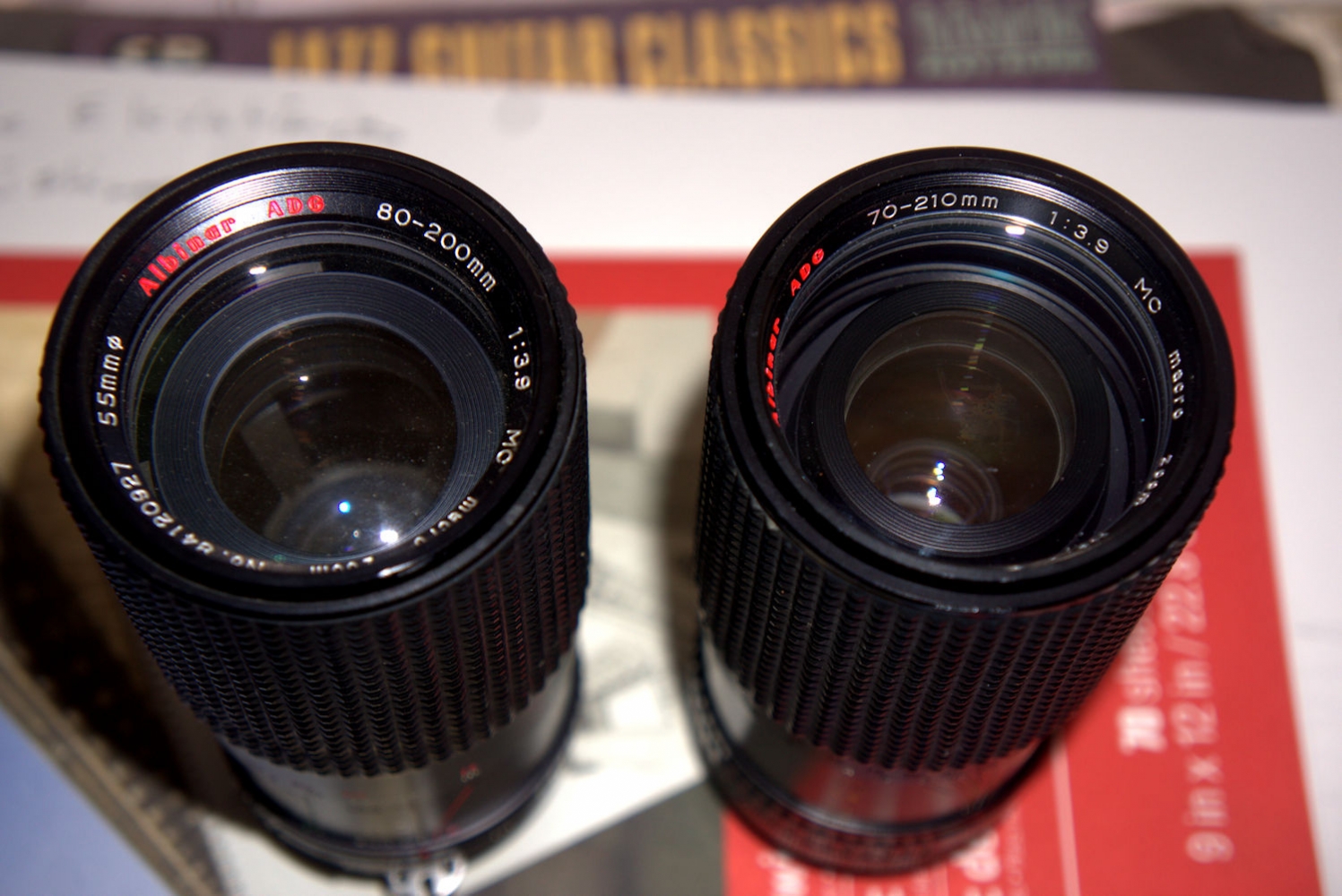

But these dissimilarities are pretty much where their differences end. Optically I found both lenses to behave very similarly. I might give the 80-200 a slight advantage over the 70-210 when used wide open at f/3.9, but once stopped down a bit, they're both essentially identical.
I began to wonder about dates, so I went over to eBay and did a search on the Albinar 80-200 f/3.9. Unfortunately, the search has raised more questions than it answered. My 80-200's serial number is eight digits and begins with 84. My 70-210's serial number is also eight digits and begins with 86. Come to find out that there were some 80-200s that had barrel engravings very similar to my 70-210's, yet had serial numbers very close to my 80-200. ??? And I found several 80-200s that had serial number higher than my 70-210's, so obviously the two models' serial numbers were not sequential or consecutive -- whatever. And I found 80-200s with a 6-digit s/n that also had barrel engravings similar to the 70-210. The six-digit s/n 80-200s also did not have "Albinar ADG" emblazoned on the bezel in Da-Glo orange. Just plain white. I suspect these 6-digit s/n lenses are the earliest ones. I don't remember my original 80-200 having that Da-Glo orange print on the bezel. So mine might have been one of those early 6-digit serial number ones. This also jives with my memory regarding the multi-colored depth of field "funnel." The six-digit s/n Albinars have it. I recall my old Albinar having it, whereas this later one I have now does not.
I found several other brand names that the 80-200 goes by: Prospec, Sakar, JC Penney, Kalimar, Nikura, Star-D, Ritzcam, Zykkor, Sirius, Craig Optics, AND Samyang!
I always suspected that the lens had been built by Samyang, but that last one nailed it for me.
So this got me curious and I did a search on "70-210 3.9." Got a lot fewer hits, but still there were several brand names, and with the exception of one AF lens, they all appear to have been built by Samyang. I've located a 70-210/3.9 on eBay that has a PK-A mount, which means it had to have been built after 1983. But I've also found 80-200/3.9s on eBay with the PK-A mount. But I haven't found any 70-210s with just a plain PK mount. So I'm still wondering how these two lenses are related to each other in the overall scheme of things. I recall that, some time in the late 80s, Albinar's 80-200 was switched to an altogether different lens: a more compact, f/4.5-5.6 variable aperture lens. Would Albinar have also offered a 70-210 at the same time? That doesn't seem likely to me. So, because there are much fewer 70-210s than 80-200s, I suspect the time line went something like this. 80-200s were built first. And the first of those were the six-digit S/N ones. Then Albinar began offering the 8-digit ones with the dressed up Da-Glo orange "Albinar ADG" on the bezel. After some number of years, Albinar switched over to the 70-210/3.9 with the Da-Glo orange bezel. Then, some time later, Albinar discontinued the 70-210 and offered the 80-200 with variable aperture. I suspect, by that time, most people were buying auto focus and Albinar was just barely hanging in there anymore. Soon after, Albinar disappeared altogether as a lens label. I did a search on eBay for AF Albinars and got zero hits. Yep, that pretty much confirms it then.
Okay, enough verbiage. I actually took both lenses out today and did some comparison shooting. The results in a nutshell are this: both lenses are rather soft wide open. Upon close examination of the wide open shots, I'm find that there's still some respectable sharpness, just a very narrow depth of field that makes one think they aren't so sharp. I also took pics at f/8 and f/16 with both lenses. By f/8, they were both producing excellent images. And by f/16, they were still hanging in there.
I ended up shooting a lot of pics, and I don't really want to load up this post with a bunch more images. So I need to figure out how to present them best. I know, I can hear you from here -- "Who cares? Images from some crap Korean lens?" Well, here's why I care. This image is a dupe from a Kodachrome slide I shot back in 1984 with a Canon A-1 and my original Albinar 80-200. The lens was probably stopped all the way down to f/22 because I know the way the A-1 meters and I had pointed it right at the sun. But I must have had it set to Shutter Priority, because if I had had it set to Program the image would have been way underexposed.

I'll put together some comparison shots in my next post.
_________________
Michael
My Gear List: http://michaelmcbroom.com/photo/gear.html
My Gallery: http://michaelmcbroom.com/gallery3/index.php/
My Flickr Page: https://www.flickr.com/photos/11308754@N08/albums
My Music: https://soundcloud.com/michaelmcbroom/albums
My Blog: http://michaelmcbroom.com/blogistan/ |
|
| Back to top |
|
 |
Lloydy


Joined: 02 Sep 2009
Posts: 7794
Location: Ironbridge. UK.
Expire: 2022-01-01
|
 Posted: Tue Jan 23, 2018 10:39 am Post subject: Posted: Tue Jan 23, 2018 10:39 am Post subject: |
 |
|
Lloydy wrote:
Many years ago, in the 80's, I bought a Ritzcam 28-85 one touch zoom for my Canon A1 & AE1P which I used a lot and it was OK. It was never a good lens - but it was 'good enough' to get acceptable pictures. Which I guess was all many of us were asking for back then?
I've got a bunch of similar 1980's zooms, mainly Miranda's, in my for sale boxes that are OK for what they are, but not good enough for the standard I want now.
_________________
LENSES & CAMERAS FOR SALE.....
I have loads of stuff that I have to get rid of, if you see me commenting about something I have got and you want one, ask me.
My Flickr https://www.flickr.com/photos/mudplugga/
My ipernity -
http://www.ipernity.com/home/294337 |
|
| Back to top |
|
 |
anktonio


Joined: 20 Oct 2012
Posts: 219
Location: Spain
Expire: 2017-02-22
|
 Posted: Tue Jan 23, 2018 12:18 pm Post subject: Posted: Tue Jan 23, 2018 12:18 pm Post subject: |
 |
|
anktonio wrote:
Well done, Michael, nice backlight. And very well controlled the flare. Unfortunately, my attitude with the zoom is of love and hate, except perhaps an MD 35-70/3.5 Macro ... the fault is mine, not theirs 
Happy shots! |
|
| Back to top |
|
 |
Oldhand


Joined: 01 Apr 2013
Posts: 6005
Location: Mid North Coast NSW - Australia
|
 Posted: Tue Jan 23, 2018 12:20 pm Post subject: Posted: Tue Jan 23, 2018 12:20 pm Post subject: |
 |
|
Oldhand wrote:
Thank you for the background Michael - it puts your two lenses into a context for us.
You are most likely right that we would almost certainly overlook these two without your back story and the evidence that you show.
This can be the case with many lenses that fall under the radar.
I have a pair of Pentax zooms that are in a similar category - SMC Pentax-M 80-200 f4.5 and the SMC Pentax Zoom 45-125 f4.
Both are very good lenses - excellent even when carefully used - but they are not popular and are often found very cheaply.
A good opportunity to obtain some quality glass at basement prices.
Tom |
|
| Back to top |
|
 |
iangreenhalgh1


Joined: 18 Mar 2011
Posts: 15679
Expire: 2014-01-07
|
 Posted: Tue Jan 23, 2018 3:00 pm Post subject: Posted: Tue Jan 23, 2018 3:00 pm Post subject: |
 |
|
iangreenhalgh1 wrote:
I don't like zooms much, only ones I use are my Minolta AF ones on my Sony a850.
I have collected a few 1960s vintage huge ones though, constant aperture two touch types to use for video, Soligor, Sigma and Sun, they are all sharp but all medium to low contrast, but they have character in their imaging, very good for video on M43 I find as they give a classical look.
As for cheap zooms, I've just picked up a few zooms very cheap, yes, my LBA kicked in again...
I got these, all from ebay:
Vivitar Series 1 22 serial 3.5/70-210 in OM mount - 6.99ukp + 2.99 postage
Olympus Zuiko Auto-Zoom f3.5-4.5 35-105mm - 4.99ukp + 2.95 postage
Olympus Zuiko Auto-Zoom f4 75-150mm - 17.56ukp + 6 postage
Olympus Zuiko Auto-Zoom f4 65-200mm - 10ukp inc. postage
Olympus Zuiko Auto-Zoom f5 100-200mm - 3.30ukp + 3.40 postage
I think those were all pretty cheap, apart from the Oly 75-150, a very common lens but most copies have issues, so I paid a bit more to get a good one.
I'm interested to compare the Viv 1 70-210 to the Oly 65-200 and my Konica Zoom-Hexanon UC 4/80-200, my current 'best' zoom in that range.
_________________
I don't care who designed it, who made it or what country it comes from - I just enjoy using it! |
|
| Back to top |
|
 |
cooltouch


Joined: 15 Jan 2009
Posts: 9096
Location: Houston, Texas
|
 Posted: Tue Jan 23, 2018 8:43 pm Post subject: Posted: Tue Jan 23, 2018 8:43 pm Post subject: |
 |
|
cooltouch wrote:
Guys, thanks for your responses. Part of what I was wanting to put across was the fact that relatively unknown and cheap lenses can often deliver very good performance, and I'm using these two zooms to prove my point. I liked reading about other cheap lenses you guys have found that deliver very good results. I'm gonna have to keep my eyes open for some of them now.
Ian, I have only two "huge" 1960s era zooms: one of the ubiquitous 90-230 zooms that I think just about every aftermarket maker sold at one time or another. Mine is a Soligor. It's in Canon FL mount. And my other one is a recent acquisition -- a Vivitar 70-260mm f/4.5. It's a 37xxxxx lens -- Tokina, which is why I bought it. I figured if it was made by Tokina -- even in the 60s -- it would be a good lens. I've only taken a few test shots with the lens so far, but they are indicating that it is actually quite nice. The lens had been worked on by an amateur and I had to dismantle it to correct the previous owner's mistakes before I could even use it. One nice thing that you can see about an old lens like this Vivitar when it is dismantled is how well (or not) it's made. In this lens's case, it was built to last. Very robust, very high quality in its build construction. The result, however, is a big, heavy lens. Thankfully it has a tripod mount.
_________________
Michael
My Gear List: http://michaelmcbroom.com/photo/gear.html
My Gallery: http://michaelmcbroom.com/gallery3/index.php/
My Flickr Page: https://www.flickr.com/photos/11308754@N08/albums
My Music: https://soundcloud.com/michaelmcbroom/albums
My Blog: http://michaelmcbroom.com/blogistan/ |
|
| Back to top |
|
 |
luisalegria


Joined: 07 Mar 2008
Posts: 6602
Location: San Francisco, USA
Expire: 2018-01-18
|
 Posted: Tue Jan 23, 2018 11:45 pm Post subject: Posted: Tue Jan 23, 2018 11:45 pm Post subject: |
 |
|
luisalegria wrote:
Good detective work!
There are probably a pile of hidden 1970's-90's Samyangs out there.
Yes indeed, there are decent no-names of all kinds.
And almost all are at least usable for general work.
And even the worst ones can have their defects worked around, especially on digital. Something can be done, always, usually along the lines of changing the character of the image you are after. This alone often leads to a better shot. A perfect lens, I think, leads to a temptation of being satisfied with a clinically clean shot, but often banal. Having to make do leads to thinking outside the box.
_________________
I like Pentax DSLR's, Exaktas, M42 bodies of all kinds, strange and cheap Japanese lenses, and am dabbling in medium format/Speed Graphic work. |
|
| Back to top |
|
 |
iangreenhalgh1


Joined: 18 Mar 2011
Posts: 15679
Expire: 2014-01-07
|
 Posted: Wed Jan 24, 2018 1:23 am Post subject: Posted: Wed Jan 24, 2018 1:23 am Post subject: |
 |
|
iangreenhalgh1 wrote:
I think I had that big honking 70-260 a few years ago, all metal, built like a tank, even bigger and heavier than my Tair-3 so I sold it on. Can't recall how it shot.
_________________
I don't care who designed it, who made it or what country it comes from - I just enjoy using it! |
|
| Back to top |
|
 |
cooltouch


Joined: 15 Jan 2009
Posts: 9096
Location: Houston, Texas
|
 Posted: Wed Jan 24, 2018 2:32 pm Post subject: Posted: Wed Jan 24, 2018 2:32 pm Post subject: |
 |
|
cooltouch wrote:
I have a few samples I took with that big Vivitar that I can show you. First, here's a couple of images of the lens itself:
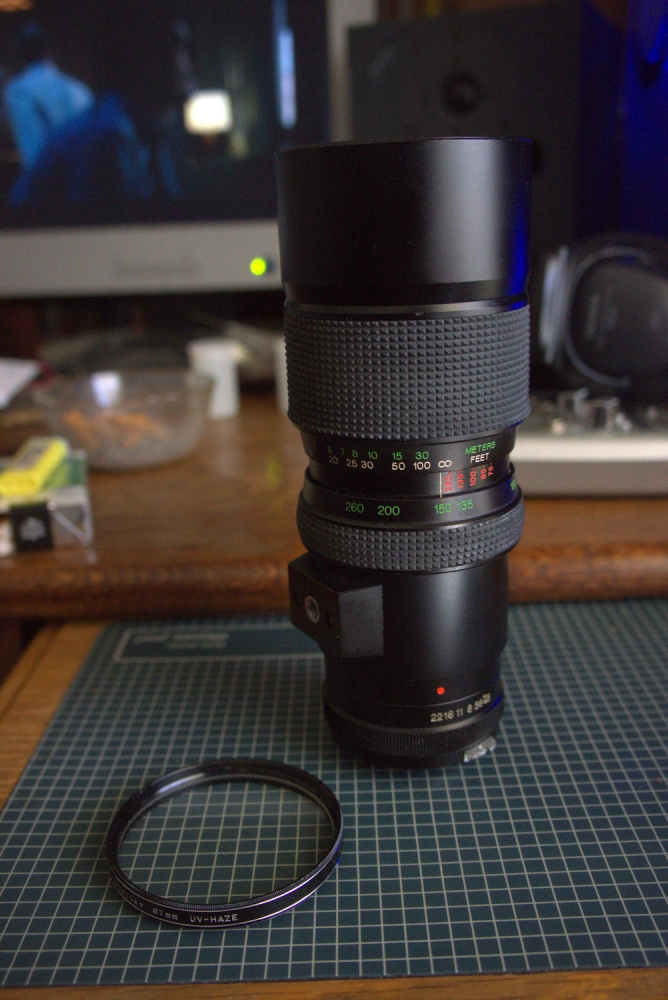
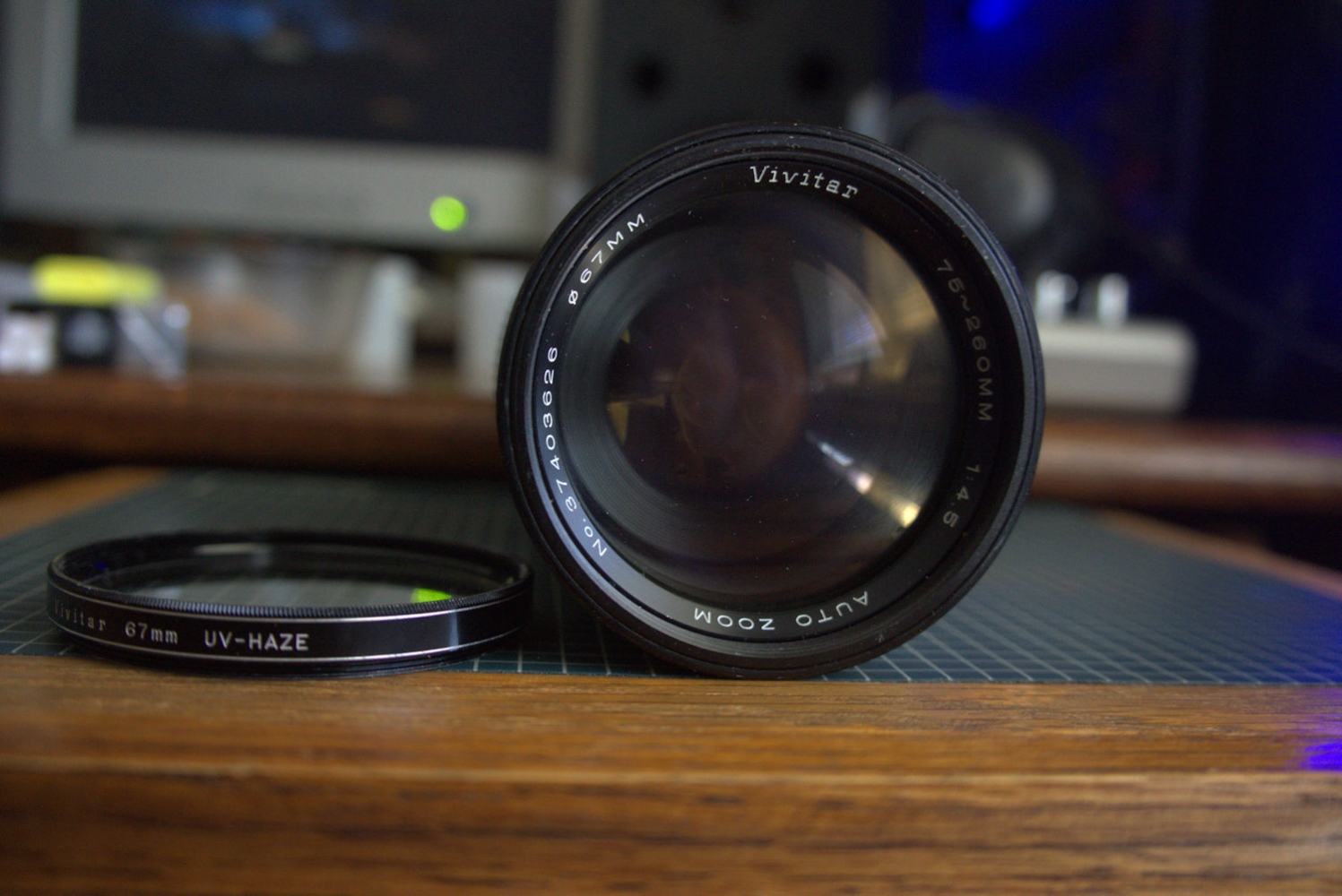
And here are a few shots I took with it yesterday -- mounted to my NEX 7, ISO 100. I had the lens set wide open at f/4.5. Yeah, it's a little soft, but not too bad. Zoom settings were various.
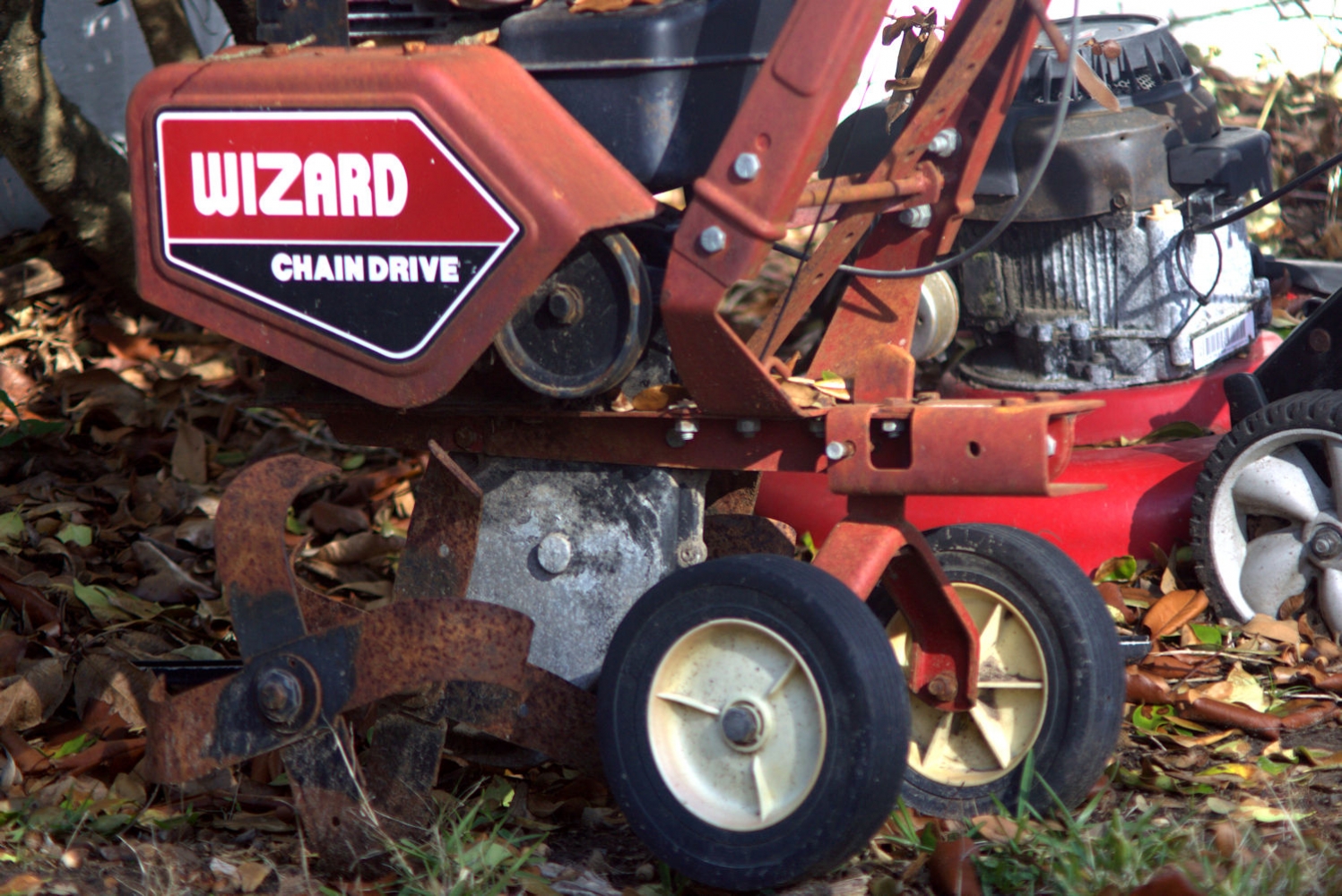

My neighbor's dog wouldn't stay still. The little mutt insisted on barking and wouldn't stop. Shutter speeds were fairly low, which didn't help matters.
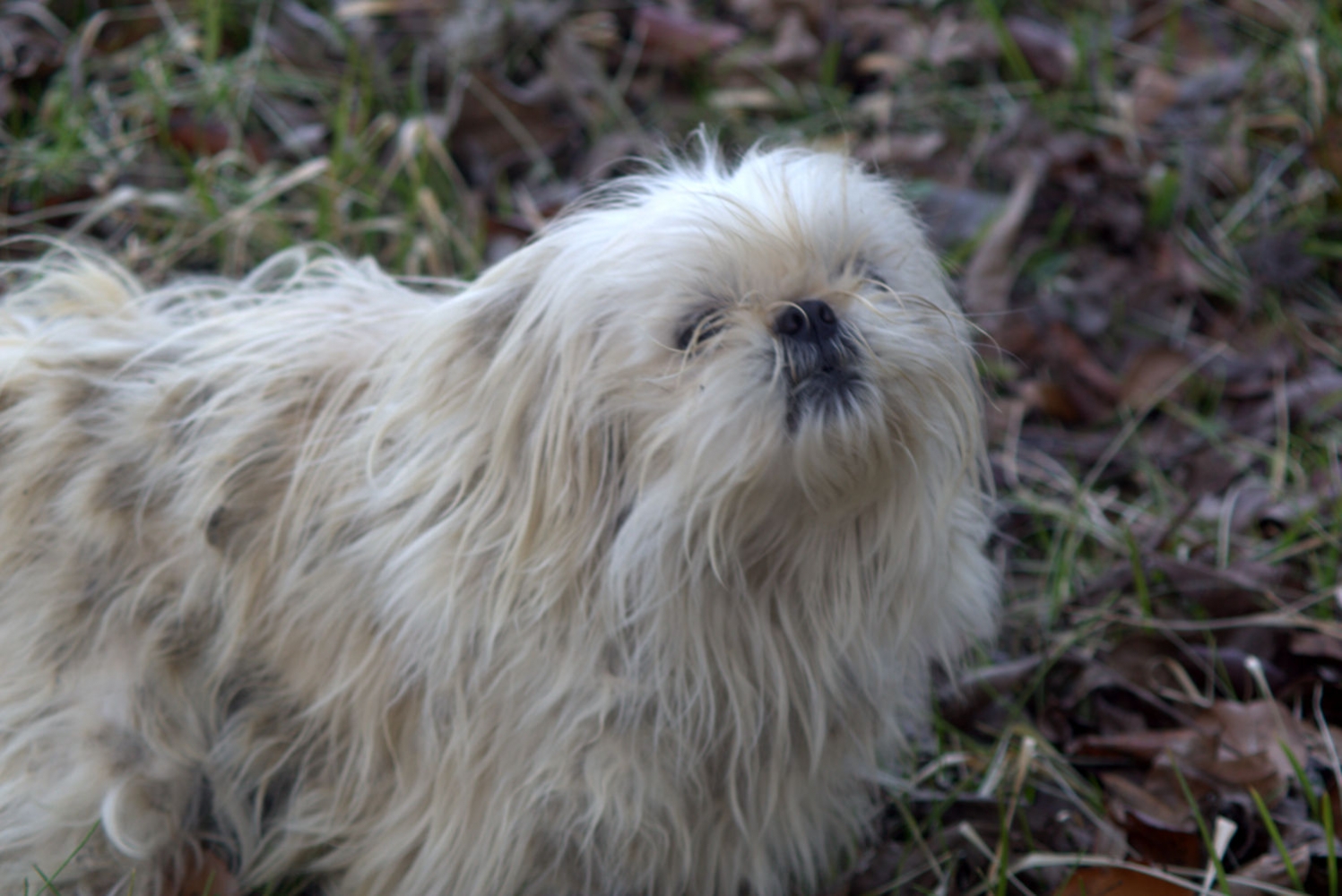
_________________
Michael
My Gear List: http://michaelmcbroom.com/photo/gear.html
My Gallery: http://michaelmcbroom.com/gallery3/index.php/
My Flickr Page: https://www.flickr.com/photos/11308754@N08/albums
My Music: https://soundcloud.com/michaelmcbroom/albums
My Blog: http://michaelmcbroom.com/blogistan/ |
|
| Back to top |
|
 |
cooltouch


Joined: 15 Jan 2009
Posts: 9096
Location: Houston, Texas
|
 Posted: Thu Jan 25, 2018 1:20 pm Post subject: Posted: Thu Jan 25, 2018 1:20 pm Post subject: |
 |
|
cooltouch wrote:
Okay, here are some shots I took with the two Samyang-made zooms. I was using a NEX 7 set to ISO 100 and I was shooting freehand, without a tripod. No post processing of any kind was done other than downsizing the image for display here. Full size images are available upon request.
Distance from me to the subject was about three meters. I had both zooms set to their widest setting, ie either 80mm or 70mm.
You'll note that, with a few of the images, I've drawn a red arrow. This is done to indicate the point of focus.
80-200mm:
f/3.9:

f/8:

f/16:

70-210mm:
f/3.9:

f/8:

f/16:

My impressions are that both lenses are somewhat soft wide open, but once stopped down a bit the sharpness is greatly improved.
_________________
Michael
My Gear List: http://michaelmcbroom.com/photo/gear.html
My Gallery: http://michaelmcbroom.com/gallery3/index.php/
My Flickr Page: https://www.flickr.com/photos/11308754@N08/albums
My Music: https://soundcloud.com/michaelmcbroom/albums
My Blog: http://michaelmcbroom.com/blogistan/
Last edited by cooltouch on Thu Jan 25, 2018 1:37 pm; edited 1 time in total |
|
| Back to top |
|
 |
cooltouch


Joined: 15 Jan 2009
Posts: 9096
Location: Houston, Texas
|
 Posted: Thu Jan 25, 2018 1:27 pm Post subject: Posted: Thu Jan 25, 2018 1:27 pm Post subject: |
 |
|
cooltouch wrote:
This next set is a pile of rocks. I've indicated the point of focus with one set. With the other, it's pretty obvious where the point of focus is.
Same camera and image data as before applies here. For these shots, I had the "macro" mode engaged, such that it is. Maximum magnification is 1:5, but I was shooting at less than that -- probably about 1:8.
80-200mm:
f/3.9:

f/8:

f/16:

70-210mm:
f/3.9:
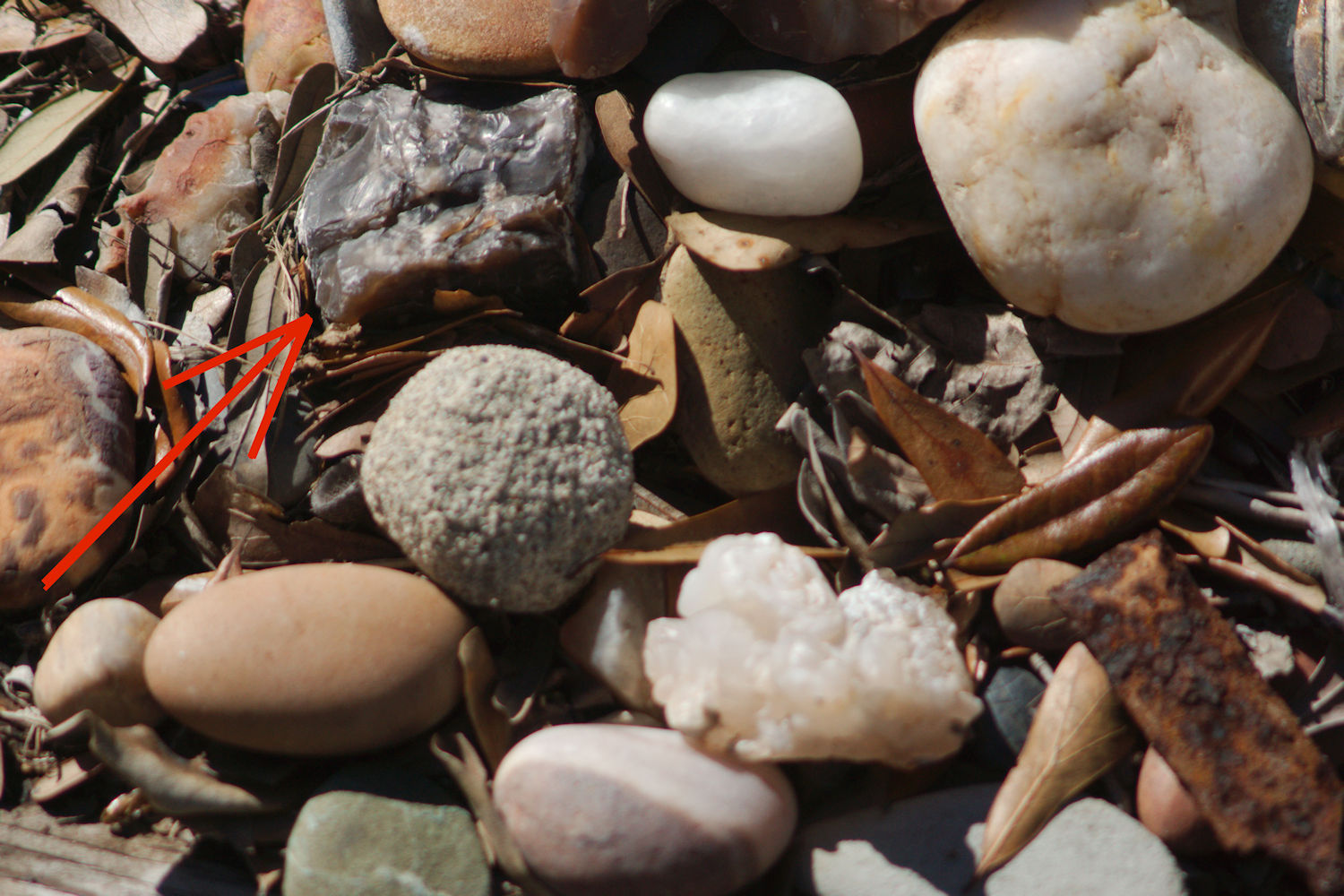
f/8:

f/16:

Same conclusion as in my previous post.
_________________
Michael
My Gear List: http://michaelmcbroom.com/photo/gear.html
My Gallery: http://michaelmcbroom.com/gallery3/index.php/
My Flickr Page: https://www.flickr.com/photos/11308754@N08/albums
My Music: https://soundcloud.com/michaelmcbroom/albums
My Blog: http://michaelmcbroom.com/blogistan/
Last edited by cooltouch on Thu Jan 25, 2018 1:39 pm; edited 1 time in total |
|
| Back to top |
|
 |
cooltouch


Joined: 15 Jan 2009
Posts: 9096
Location: Houston, Texas
|
 Posted: Thu Jan 25, 2018 1:34 pm Post subject: Posted: Thu Jan 25, 2018 1:34 pm Post subject: |
 |
|
cooltouch wrote:
Yet another set of images. Camera and image data are same as before. I've used an arrow with the 70-210 at f/3.9 to indicate point of focus.
The "macro" mode was used in these shots also, such that it is. Probably around 1:8 magnification or so.
80-200mm:
f/3.9:

f/8:
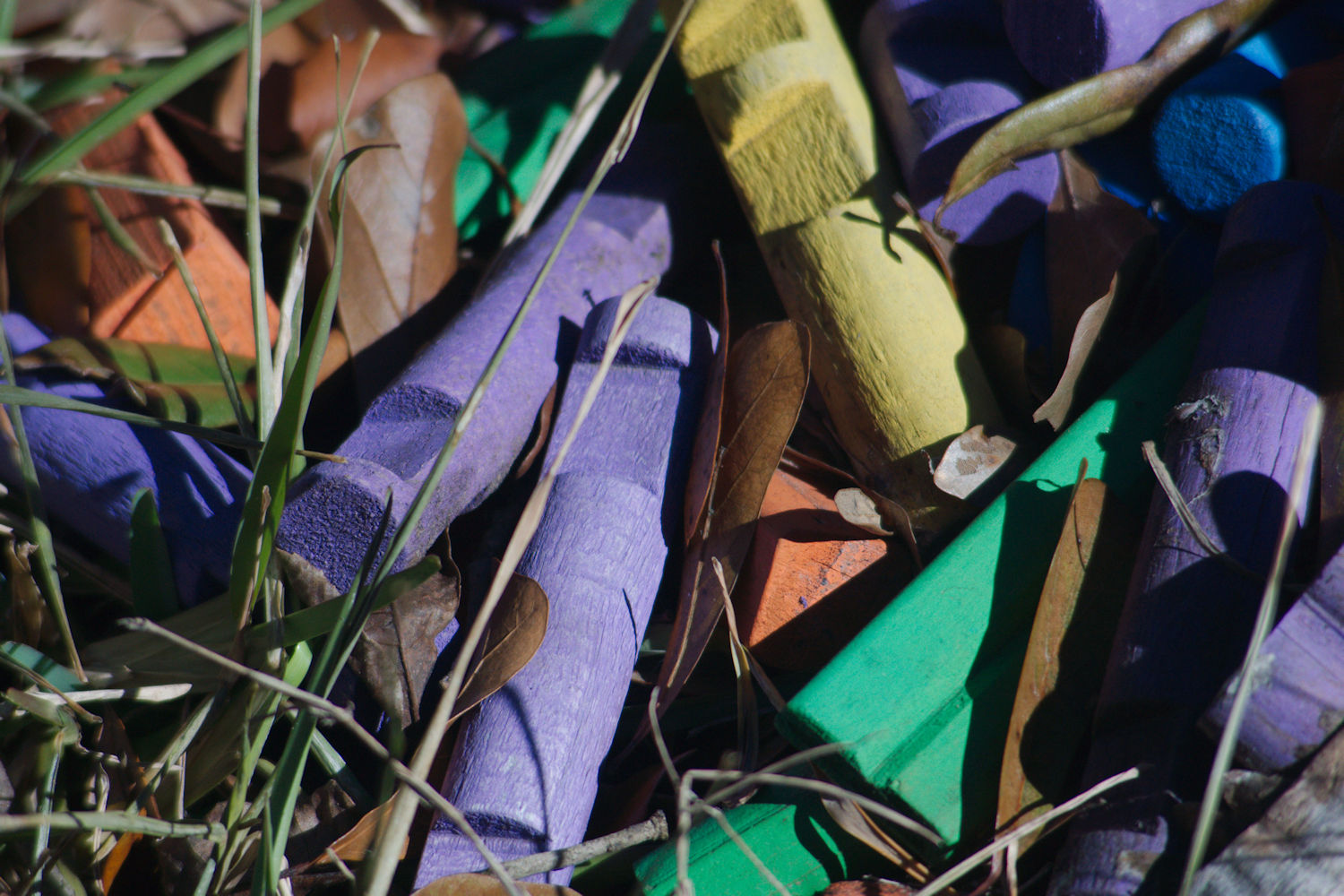
f/16:
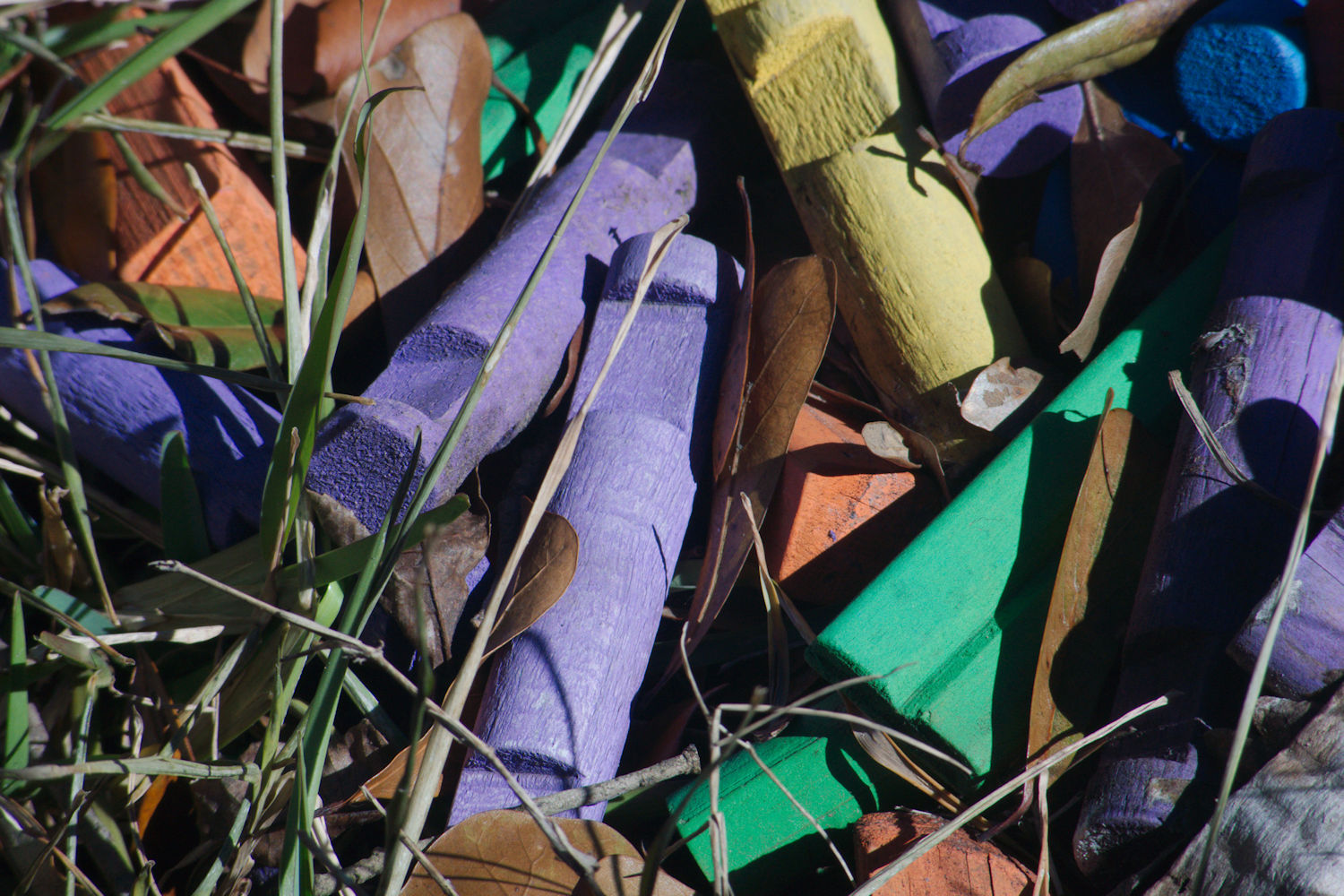
70-210mm:
f/3.9:
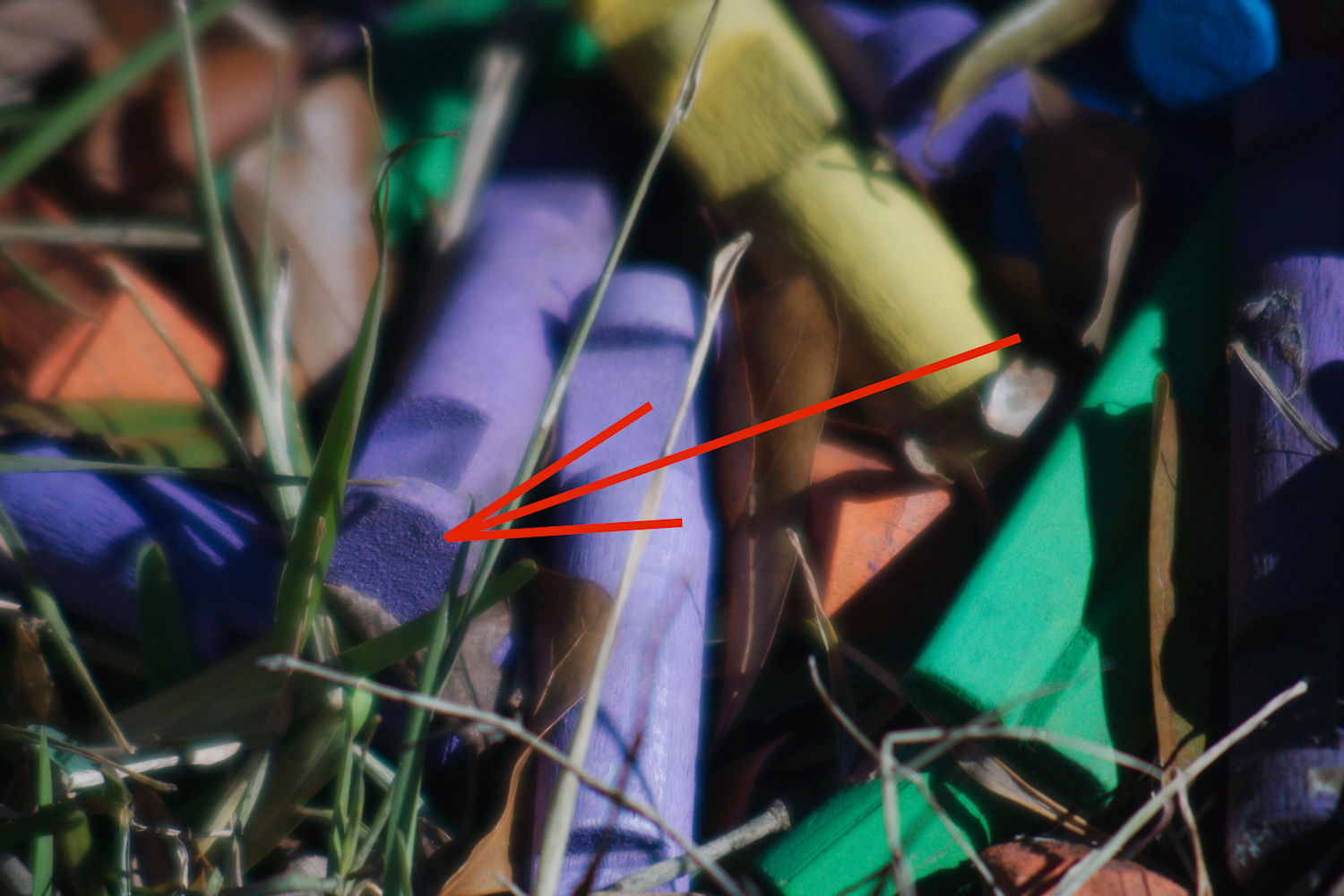
f8:
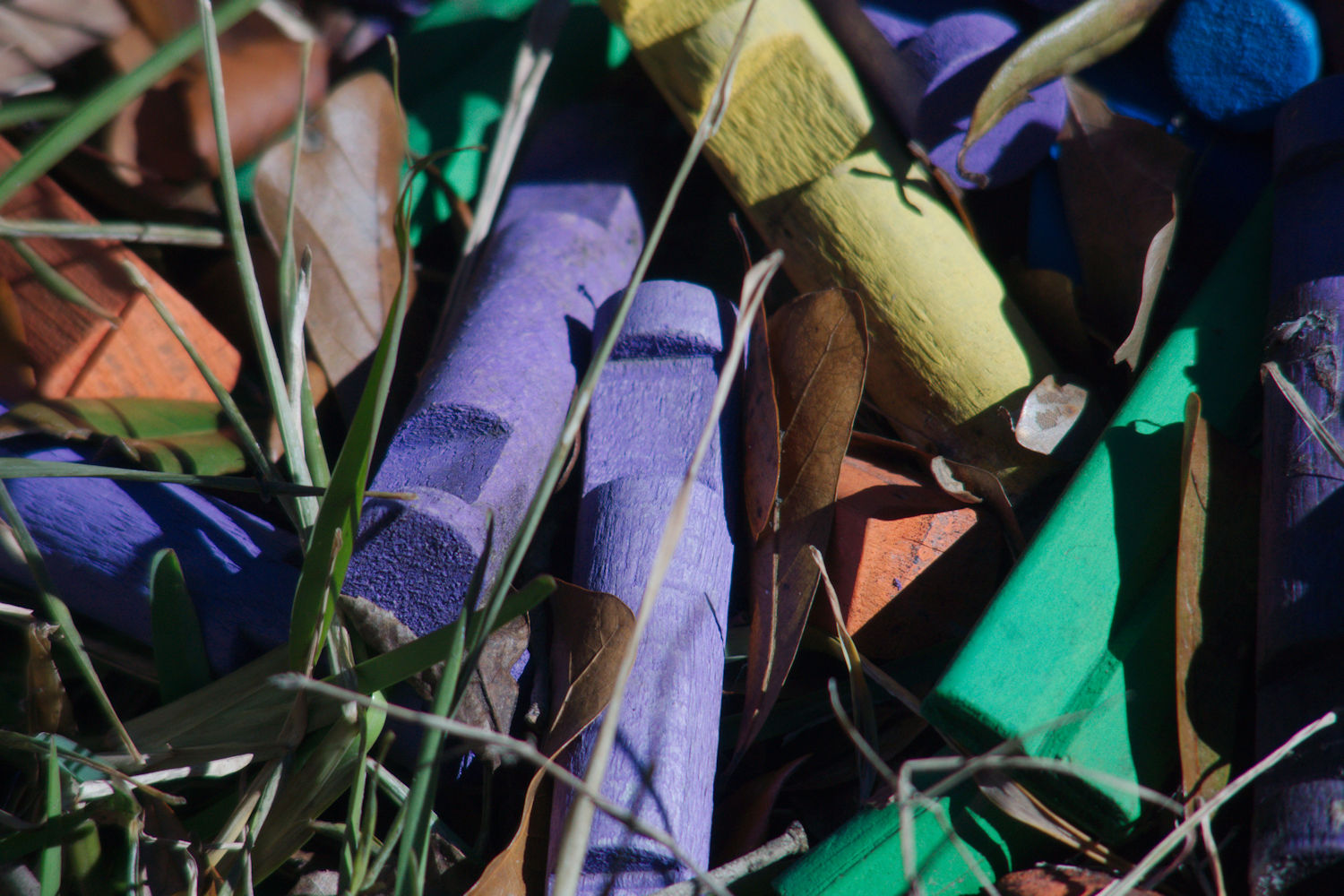
f/16:
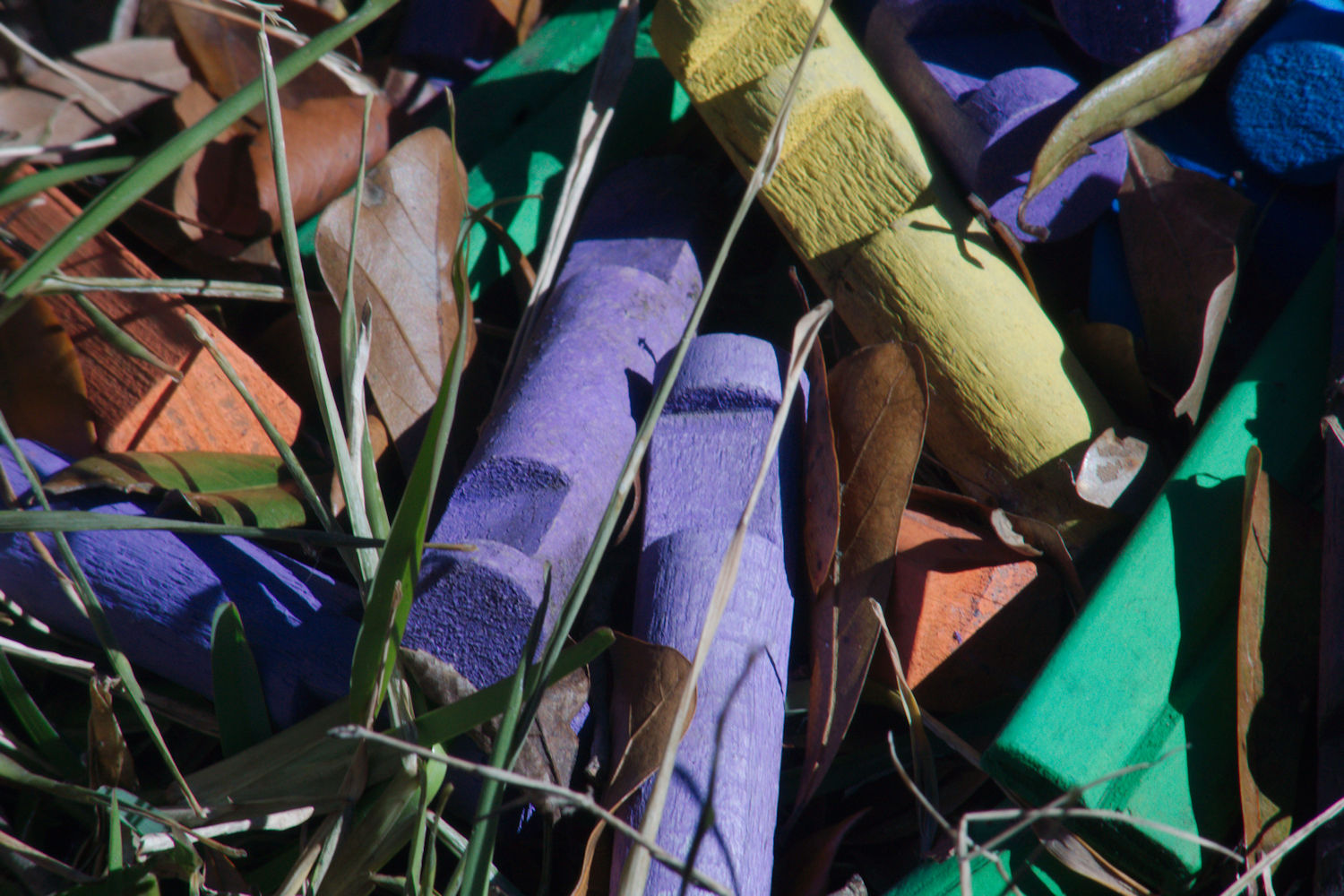
_________________
Michael
My Gear List: http://michaelmcbroom.com/photo/gear.html
My Gallery: http://michaelmcbroom.com/gallery3/index.php/
My Flickr Page: https://www.flickr.com/photos/11308754@N08/albums
My Music: https://soundcloud.com/michaelmcbroom/albums
My Blog: http://michaelmcbroom.com/blogistan/ |
|
| Back to top |
|
 |
cooltouch


Joined: 15 Jan 2009
Posts: 9096
Location: Houston, Texas
|
 Posted: Thu Jan 25, 2018 1:48 pm Post subject: Posted: Thu Jan 25, 2018 1:48 pm Post subject: |
 |
|
cooltouch wrote:
This is the last group of images I shot with these two lenses. Boring shrubs, but I took these shots because of the high contrast that exists between the plants' branches and the white wall behind. Perfect conditions to see what sort of chromatic aberrations, if any, the two lenses display. Same camera and lens data as before. Distance from myself to the subject was about three meters. I was shooting at the lenses' widest settings, ie 70mm and 80mm.
80-200mm:
f/3.9:

f/8:

f16:
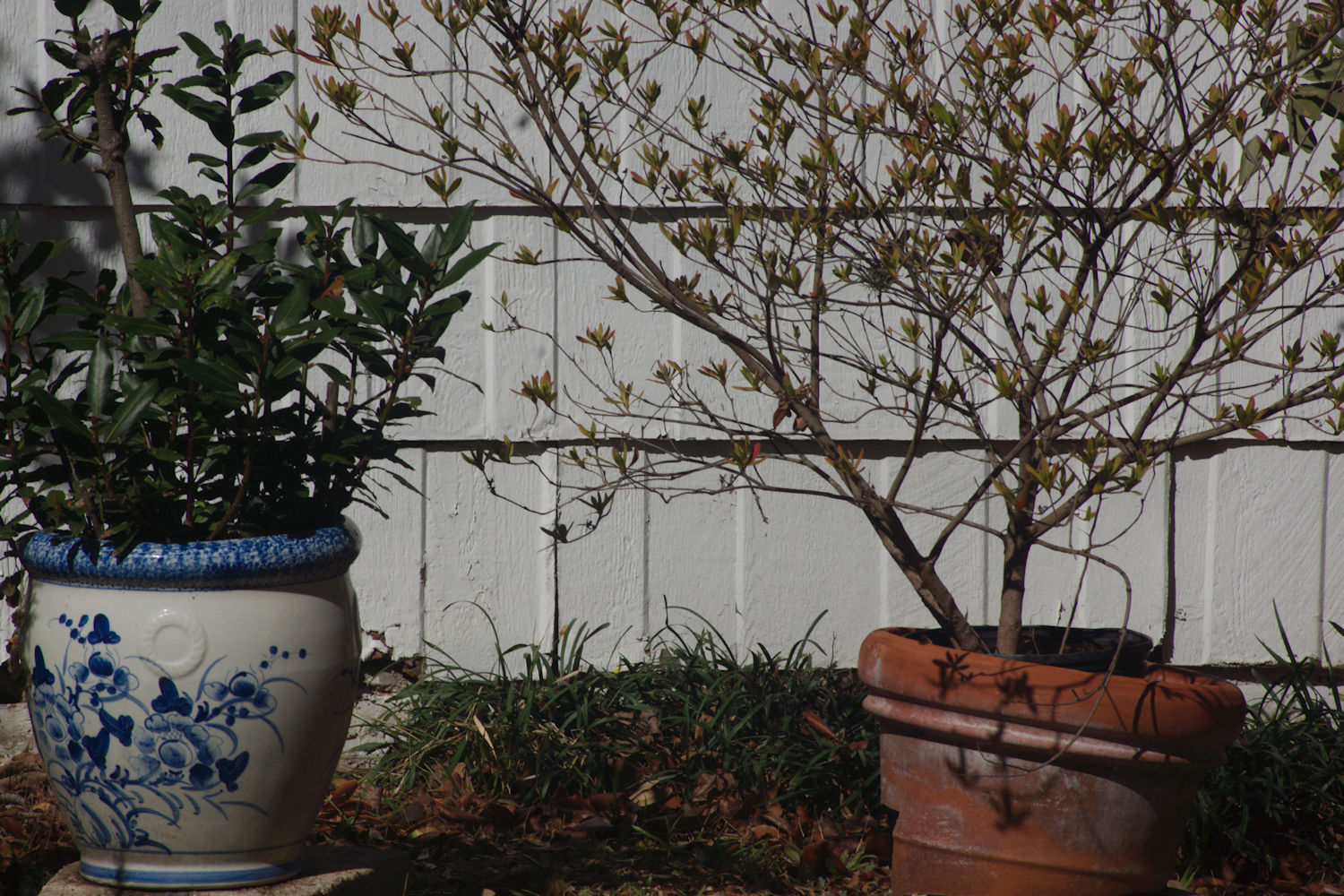
70-210mm:
f/3.9:
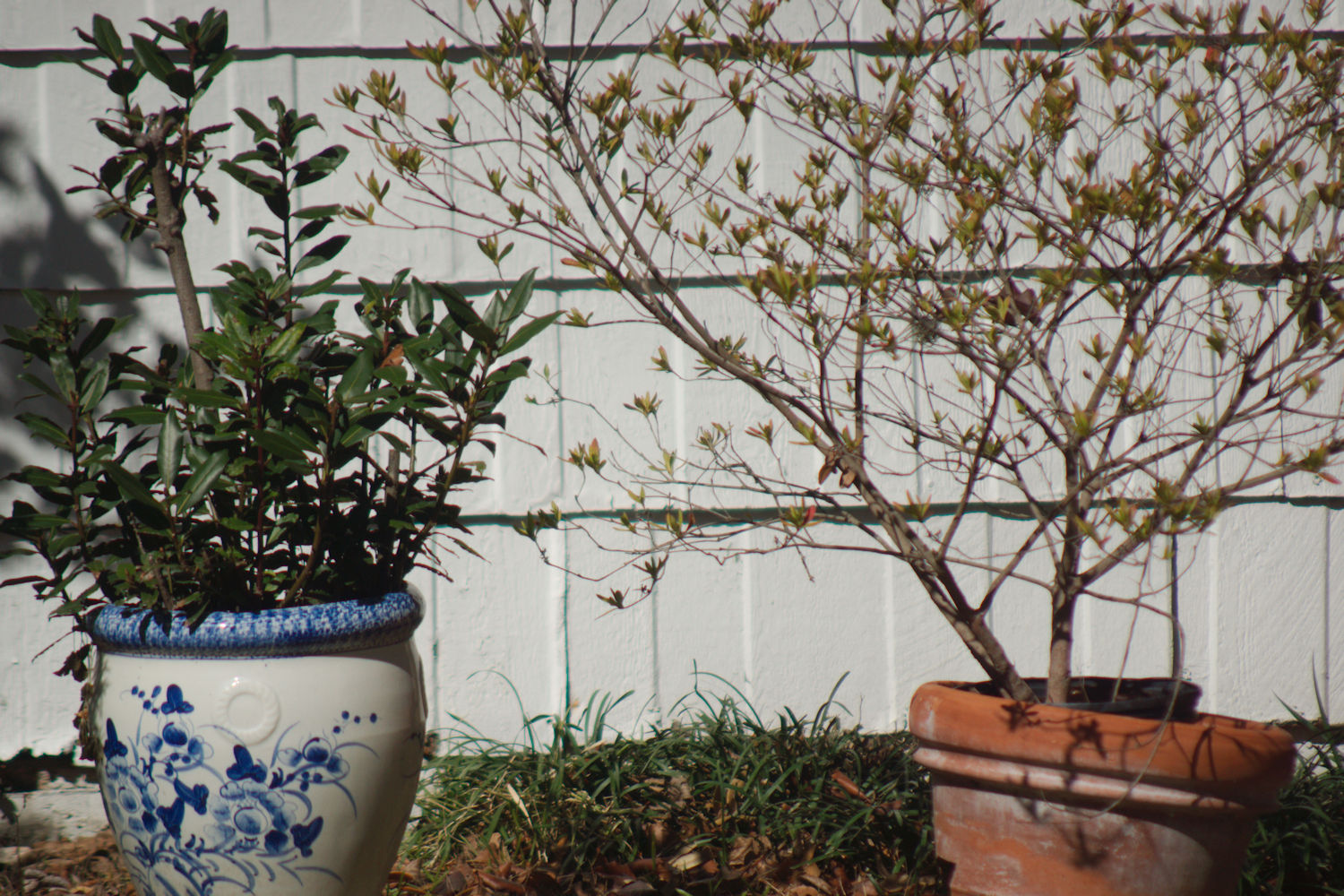
f/8:

f/16:
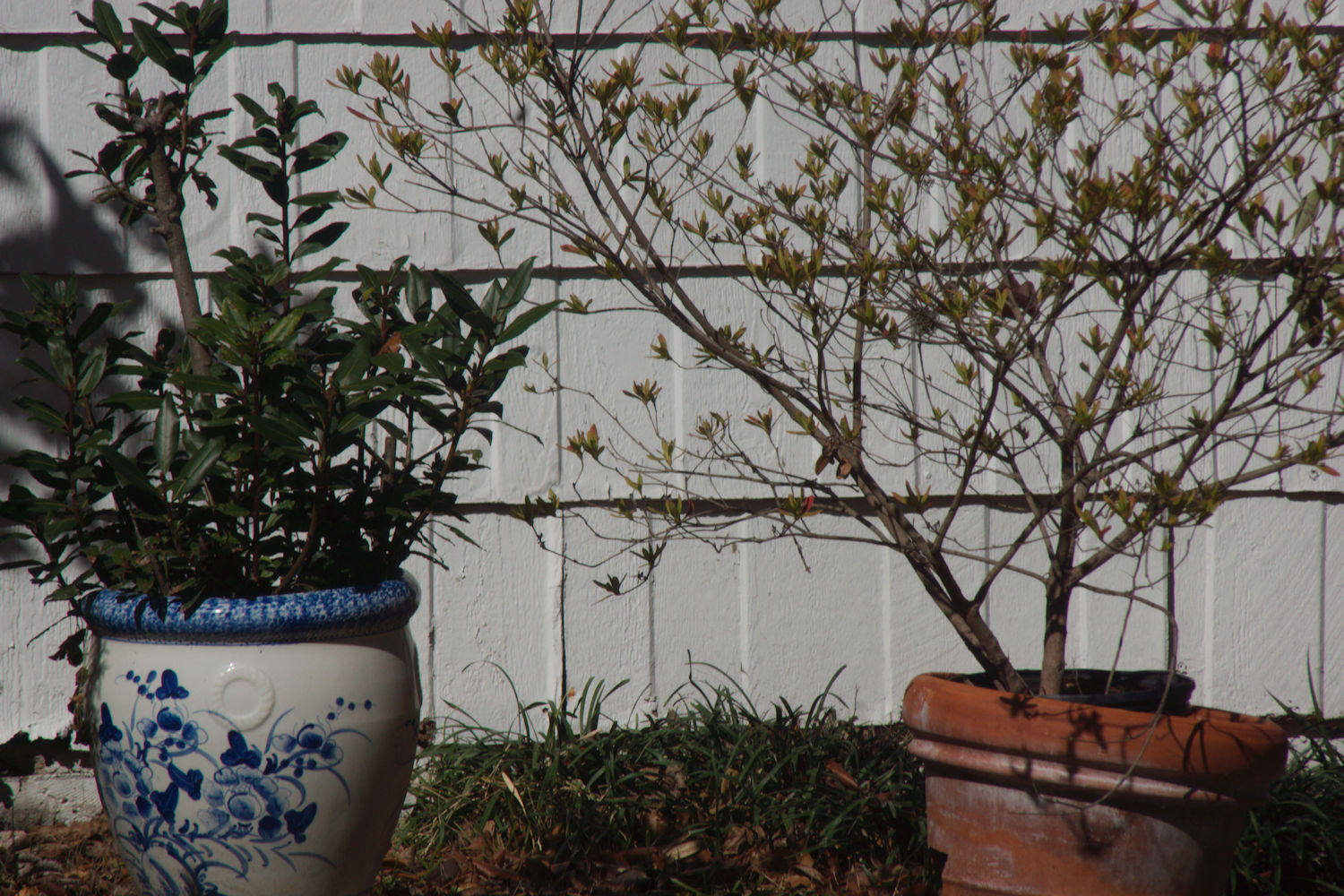
_________________
Michael
My Gear List: http://michaelmcbroom.com/photo/gear.html
My Gallery: http://michaelmcbroom.com/gallery3/index.php/
My Flickr Page: https://www.flickr.com/photos/11308754@N08/albums
My Music: https://soundcloud.com/michaelmcbroom/albums
My Blog: http://michaelmcbroom.com/blogistan/ |
|
| Back to top |
|
 |
cooltouch


Joined: 15 Jan 2009
Posts: 9096
Location: Houston, Texas
|
 Posted: Thu Jan 25, 2018 2:11 pm Post subject: Posted: Thu Jan 25, 2018 2:11 pm Post subject: |
 |
|
cooltouch wrote:
Okay, I realize you can't tell much about chromatic aberrations from the magnification of the preceding images, so I've put together six 100% crops, three from each zoom. You'll note that there's a fair amount of fringing with the lenses wide open, but by the time I've stopped them down some, the CA is brought well under control.
Note not only the purple fringing from the branches, but also note the green fringing along the horizontal line created by the exterior side paneling.
80-200mm:
f/3.9:
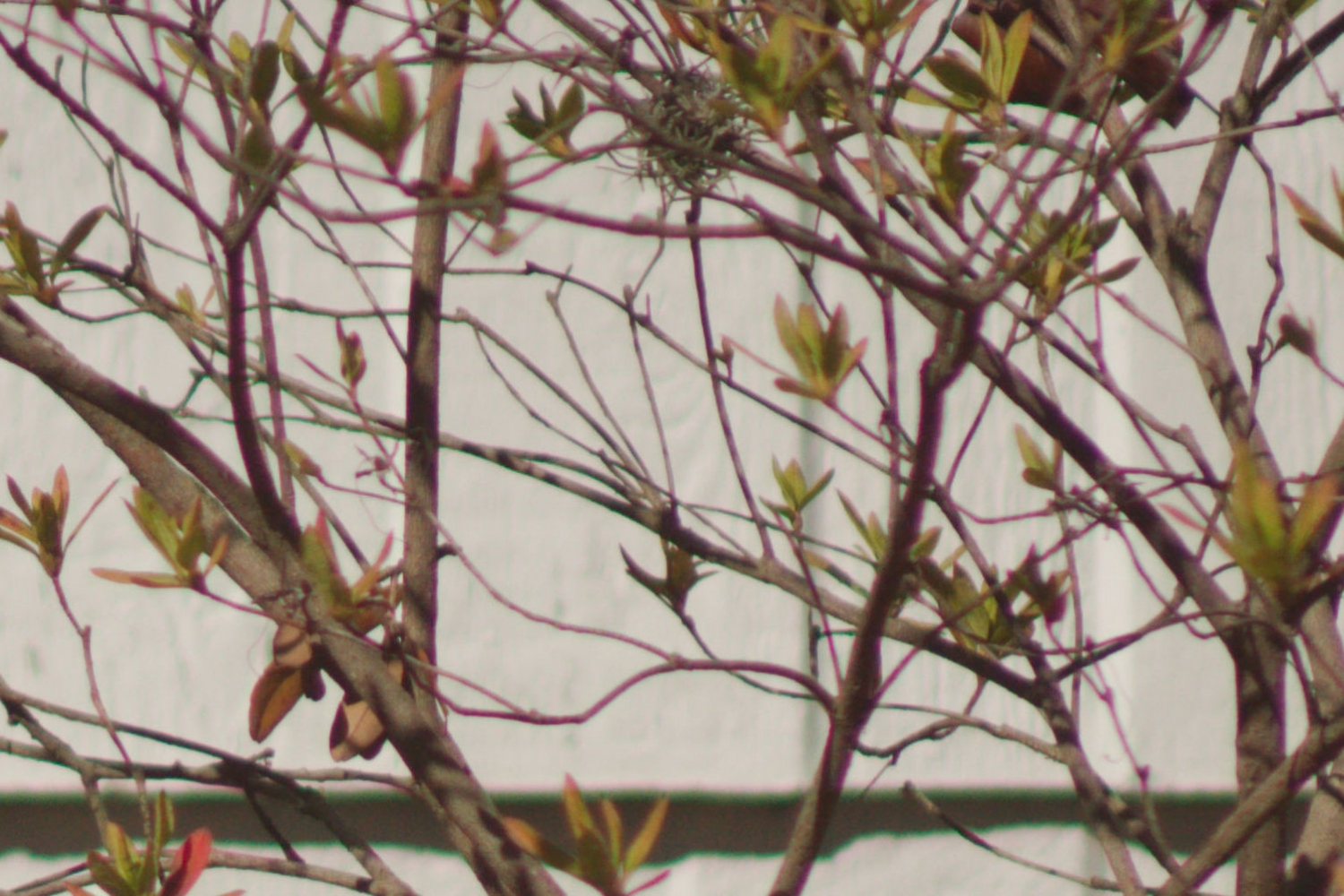
f/8 -- at this point, the green fringing is gone and the purple is greatly reduced:
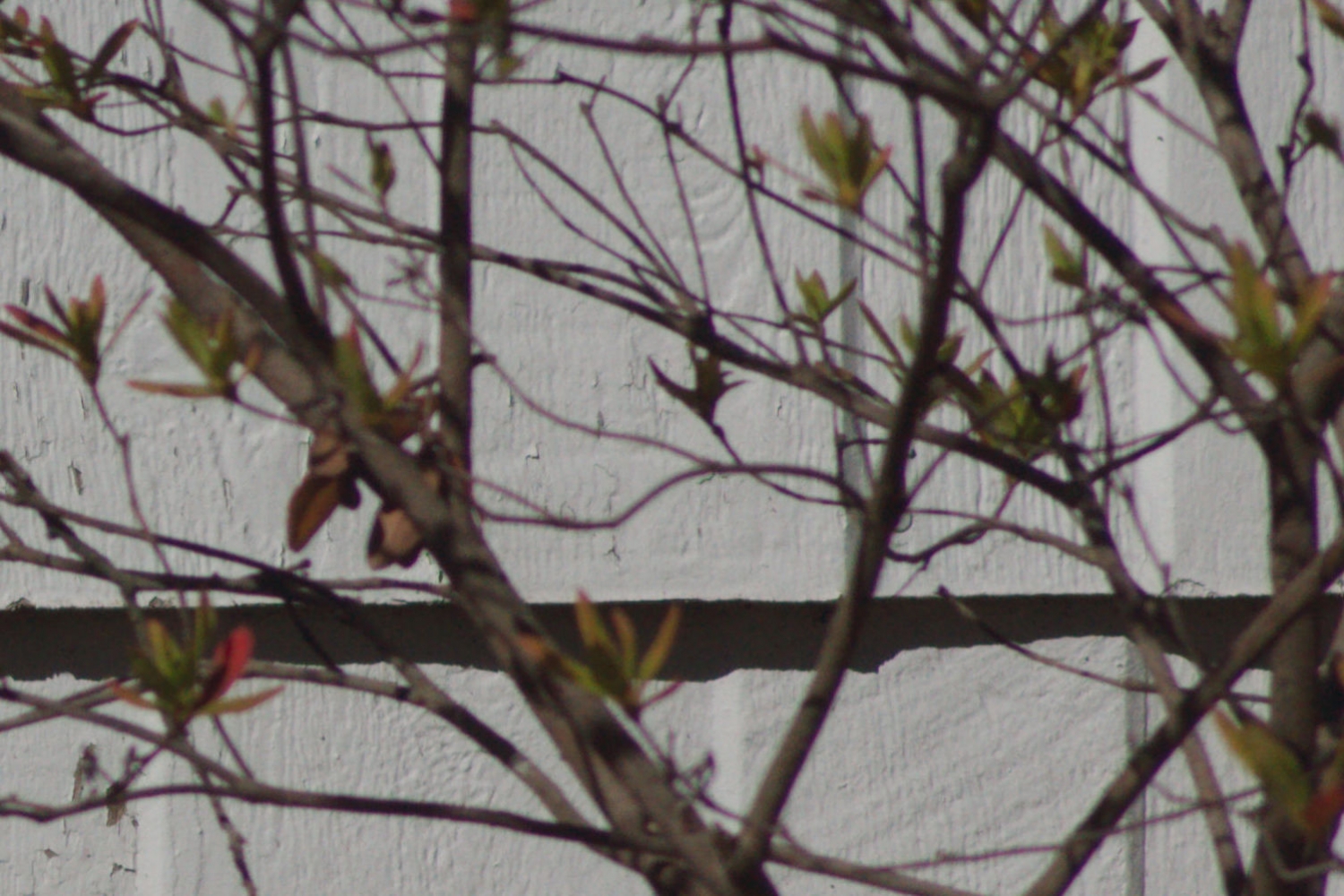
f!6 -- and at this point almost all traces of purple fringing are gone.
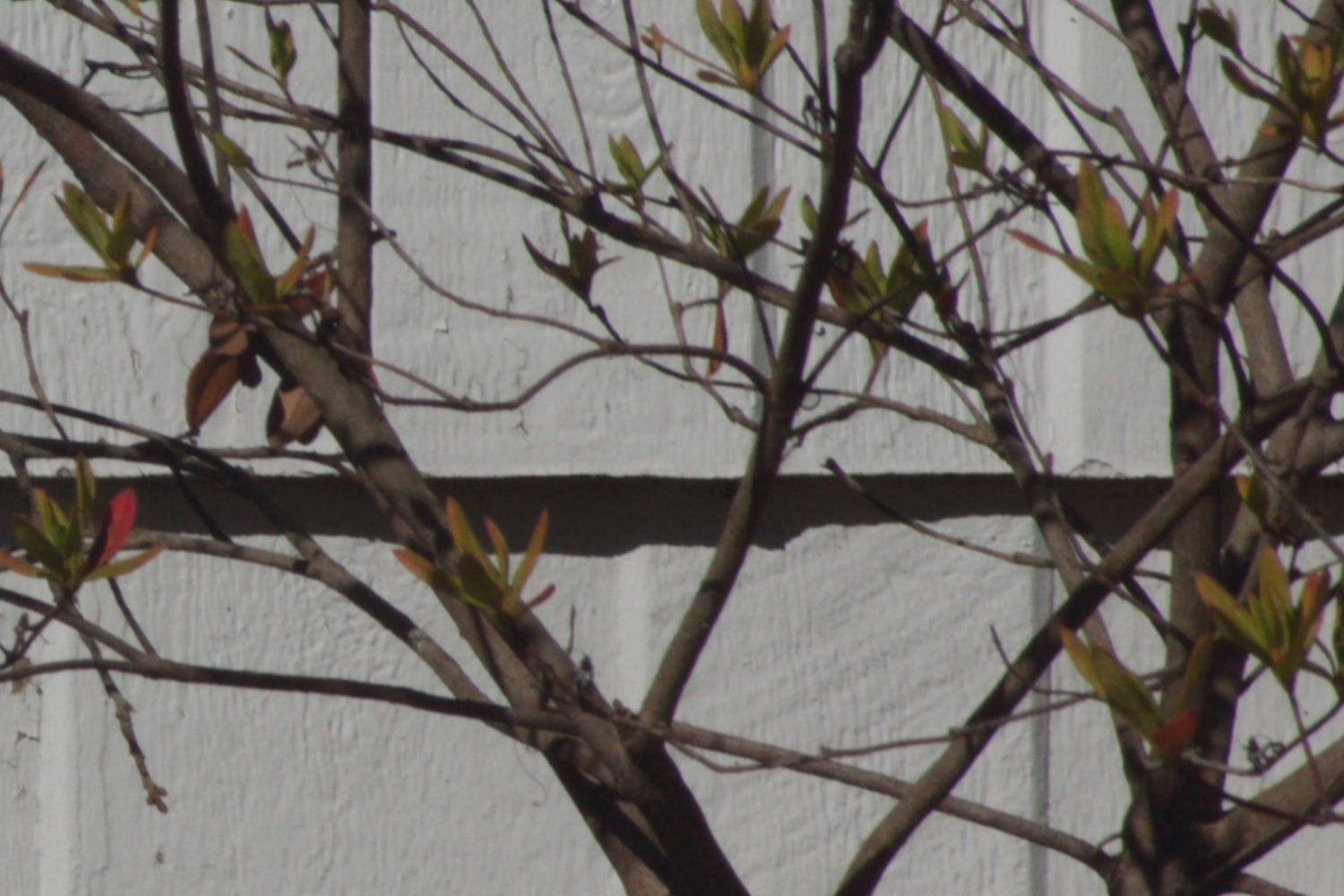
70-210mm:
f/3.9 -- At this point, much the same as the 80-200. Obvious purple fringing against the bush's branches, and pronounced green fringing from the side paneling.

f/8 -- green fringing all but gone and purple fringing is greatly reduced.
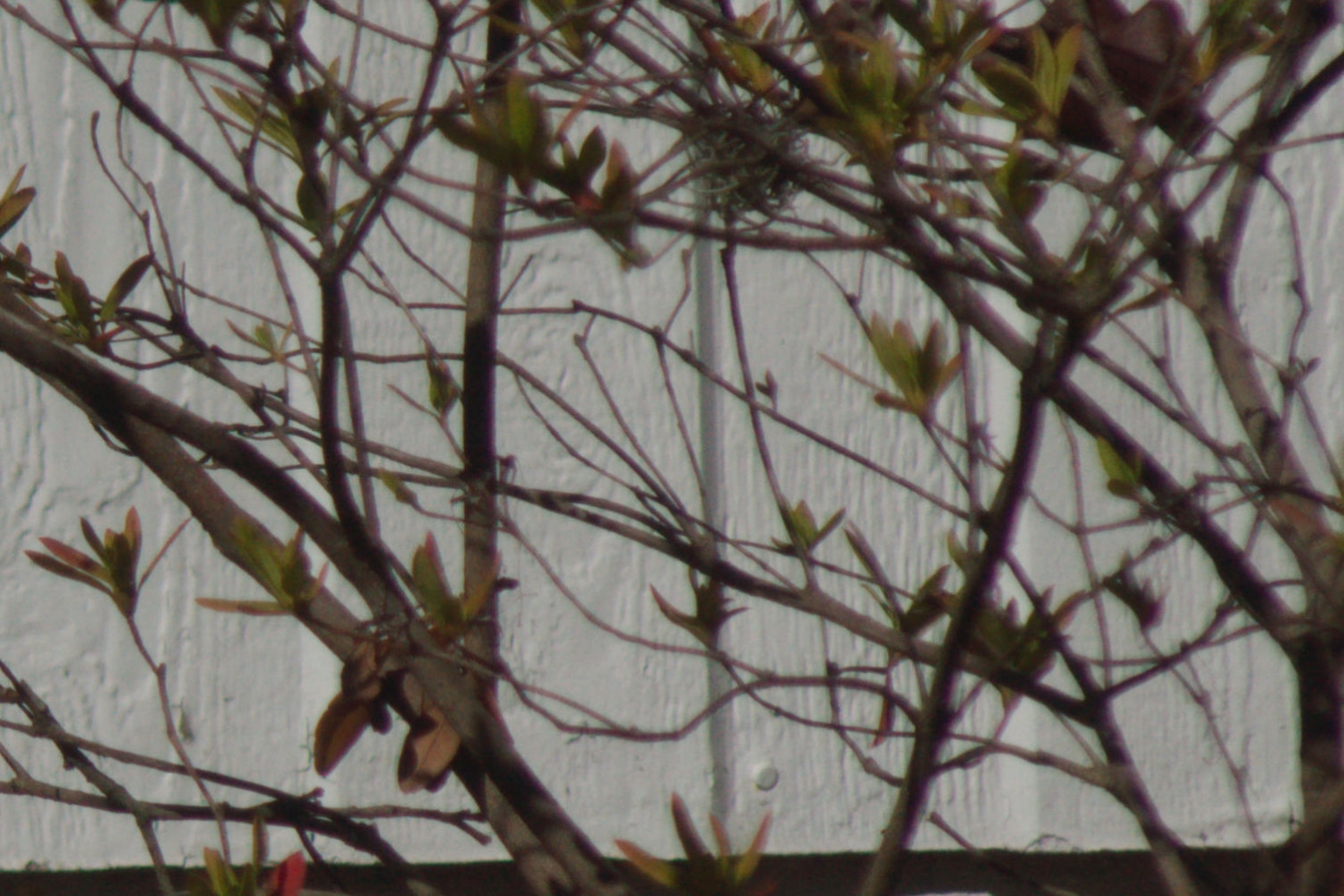
f/16 -- green fringing is gone and purple fringing is mostly gone.

So, regarding CA, I'd have to say that these two zooms handle it better than quite a few other lenses I've come across. And while it's true that, nowadays, CA can usually be removed in post processing, it's nice to see that it isn't necessarily required with these two zooms.
_________________
Michael
My Gear List: http://michaelmcbroom.com/photo/gear.html
My Gallery: http://michaelmcbroom.com/gallery3/index.php/
My Flickr Page: https://www.flickr.com/photos/11308754@N08/albums
My Music: https://soundcloud.com/michaelmcbroom/albums
My Blog: http://michaelmcbroom.com/blogistan/ |
|
| Back to top |
|
 |
iangreenhalgh1


Joined: 18 Mar 2011
Posts: 15679
Expire: 2014-01-07
|
 Posted: Fri Jan 26, 2018 1:49 am Post subject: Posted: Fri Jan 26, 2018 1:49 am Post subject: |
 |
|
iangreenhalgh1 wrote:
Interesting stuff, cheers for the hard work. You've inspired me to drag out my zooms in this range to compare:
Olympus Zuiko Auto-Zoom f4 65-200mm
Olympus Zuiko Auto-Zoom f5 100-200mm
Vivitar Series 1 f3.5 70-210mm Kiron
Tamron 103A 3.8-4/80-210
Konica UC Zoom-Hexanon 4/80-200
Kiron 4/80-200 Zoom Lock
The only one of these I have used before is the Konica and it's superb for what it is. I'm expecting the others to all be pretty good too.
_________________
I don't care who designed it, who made it or what country it comes from - I just enjoy using it! |
|
| Back to top |
|
 |
Focusthrow

Joined: 12 Sep 2017
Posts: 209
|
 Posted: Fri Jan 26, 2018 2:41 am Post subject: Posted: Fri Jan 26, 2018 2:41 am Post subject: |
 |
|
Focusthrow wrote:
Cool thread Michael--reminds me of why I love MF glass--particularly the older stuff. I find something about manual focusing which completes photography & brings great satisfaction. For me, AF is boring and a step back for the art aspect of things. Obviously, if I made a living grabbing pics of sprinters in the 100 dash or similar shooting, AF would be necessary. This is a great forum. Best jt
I've got an old, though it looks new, 80-200 f/4.5 Kiron zoom that I love--So, as they say in the vernacular, I hear man!  |
|
| Back to top |
|
 |
cooltouch


Joined: 15 Jan 2009
Posts: 9096
Location: Houston, Texas
|
 Posted: Fri Jan 26, 2018 3:11 pm Post subject: Posted: Fri Jan 26, 2018 3:11 pm Post subject: |
 |
|
cooltouch wrote:
Thanks for the feedback, y'all. Well, if I can inspire others to pull out and dust off some of their old lenses, that's a plus in my book. I'll wager that, in many cases, the photographer will be surprised at how good that old glass is.
Focusthrow, back in the 80s and early 90s, I used to freelance as a motor sports photographer. All my gear was manual focus. I developed a technique where I could almost always get a fast subject in focus. Some call it "trap focus." What I would do would be to focus on a specific spot on the racetrack before the cars ran over it. And then whenever a car that I wanted a pic of ran over that spot, I'd take the shot. The result was like a 90% hit rate. I don't see why this same sort of technique wouldn't work in track and field as well.
A couple years ago, I made it out to a motorcycle race. First motor sports venue I'd been to in years. I was shooting with my NEX 7 and Tamron 60B SP 300mm f/2.8 LDIF. And I used the same technique. It was almost boringly predictable. Almost all of my shots were in good focus. The few that weren't I could attribute to "operator error." My only real mistake was setting the NEX to Aperture priority. It selected shutter speeds that were too high. On panning shots, I want the wheels to be a blur, that way there is a sensation of speed. Take a look at the one panning shot, the second image. The bike looks like it's been frozen in place. Not the way it should look. I should have been shooting at 1/250 or slower.



_________________
Michael
My Gear List: http://michaelmcbroom.com/photo/gear.html
My Gallery: http://michaelmcbroom.com/gallery3/index.php/
My Flickr Page: https://www.flickr.com/photos/11308754@N08/albums
My Music: https://soundcloud.com/michaelmcbroom/albums
My Blog: http://michaelmcbroom.com/blogistan/ |
|
| Back to top |
|
 |
Focusthrow

Joined: 12 Sep 2017
Posts: 209
|
 Posted: Mon Jan 29, 2018 7:31 pm Post subject: Posted: Mon Jan 29, 2018 7:31 pm Post subject: |
 |
|
Focusthrow wrote:
| cooltouch wrote: |
Thanks for the feedback, y'all. Well, if I can inspire others to pull out and dust off some of their old lenses, that's a plus in my book. I'll wager that, in many cases, the photographer will be surprised at how good that old glass is.
Focusthrow, back in the 80s and early 90s, I used to freelance as a motor sports photographer. All my gear was manual focus. I developed a technique where I could almost always get a fast subject in focus. Some call it "trap focus." What I would do would be to focus on a specific spot on the racetrack before the cars ran over it. And then whenever a car that I wanted a pic of ran over that spot, I'd take the shot. The result was like a 90% hit rate. I don't see why this same sort of technique wouldn't work in track and field as well.
A couple years ago, I made it out to a motorcycle race. First motor sports venue I'd been to in years. I was shooting with my NEX 7 and Tamron 60B SP 300mm f/2.8 LDIF. And I used the same technique. It was almost boringly predictable. Almost all of my shots were in good focus. The few that weren't I could attribute to "operator error." My only real mistake was setting the NEX to Aperture priority. It selected shutter speeds that were too high. On panning shots, I want the wheels to be a blur, that way there is a sensation of speed. Take a look at the one panning shot, the second image. The bike looks like it's been frozen in place. Not the way it should look. I should have been shooting at 1/250 or slower.
|
Hey Mike:
Excellent cycle shots--thanks for sharing!
Agreed--trap focus with moving subjects can be a nice & effective strategy. When you are shooting races where vehicles circle a track multiple times, in particular. However, IME, something like a 100-meter dash, where you get 10 or more seconds of shooting for the entire event, trap focus becomes of limited utility. This is where a DSLR’s AF, along with multiple frames per second, makes it exponentially much more possible to get a superb shot. Sometimes, getting just the right facial expression, or muscle extension on the athlete, can really make the shot.
If I had someone charging @ me with a bayonet on the end of their rifle, I sure would rather have a semi-automatic rifle than a musket.
jt |
|
| Back to top |
|
 |
cooltouch


Joined: 15 Jan 2009
Posts: 9096
Location: Houston, Texas
|
 Posted: Tue Jan 30, 2018 5:57 am Post subject: Posted: Tue Jan 30, 2018 5:57 am Post subject: |
 |
|
cooltouch wrote:
Good analogy. I would only modify the setting such that I'd be equipped with a select-fire weapon (semi or full auto) just to even the odds even a bit more 
As for the utility of trap focus, yeah I can understand where you're coming from. But back when I was doing a lot of motor sports freelancing, my tools were old F-1s with motor drives that operated at a rather leisurely 3.5 fps. Later, after switching to Nikon, I had cameras with 5fps motor drives, but they were still manual focus, so I had to pick the spots. I had to make do with the tools I had available. Truth be told, it really wasn't until the advent of the F5 that a motorsports photographer could count on most any of his/her shots being in focus (and correctly exposed, no less), regardless of the angle and focal length. Prior to the F5, AF was just too slow. I don't know what the DSLR equivalent to the F5 is in the Nikon ranks, and I don't happen to know if Canon or Sony or Pentax even has a DSLR (or mirrorless for that matter) that can match the F5's performance capabilities. But I would need something with that level of performance before I'd feel confident to just let the equipment handle it.
Nonetheless, this is a manual focus lens forum, so all that is sort of moot points anyway.
_________________
Michael
My Gear List: http://michaelmcbroom.com/photo/gear.html
My Gallery: http://michaelmcbroom.com/gallery3/index.php/
My Flickr Page: https://www.flickr.com/photos/11308754@N08/albums
My Music: https://soundcloud.com/michaelmcbroom/albums
My Blog: http://michaelmcbroom.com/blogistan/ |
|
| Back to top |
|
 |
Lloydy


Joined: 02 Sep 2009
Posts: 7794
Location: Ironbridge. UK.
Expire: 2022-01-01
|
 Posted: Tue Jan 30, 2018 1:59 pm Post subject: Posted: Tue Jan 30, 2018 1:59 pm Post subject: |
 |
|
Lloydy wrote:
I used trap focus with some manual lenses on my Pentax K10 and it was excellent. It would only do one shot, but it was deadly accurate.
Mainly I used it for close focus and macro, letting the focus confirmation trigger the camera as I moved it slowly towards the subject, but I used it for motor sport as well by setting the focus point and the moving car triggered it.
_________________
LENSES & CAMERAS FOR SALE.....
I have loads of stuff that I have to get rid of, if you see me commenting about something I have got and you want one, ask me.
My Flickr https://www.flickr.com/photos/mudplugga/
My ipernity -
http://www.ipernity.com/home/294337 |
|
| Back to top |
|
 |
|
|
